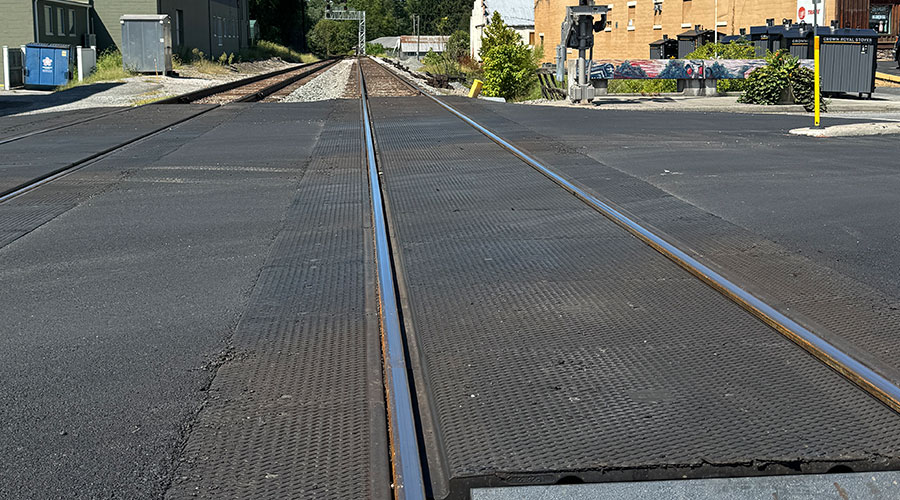Stay updated on news, articles and information for the rail industry
 railPrime
railPrime
February 2012
Rail News: C&S
Positive train control: FRA expects to ramp up PTC regulatory efforts as railroads amp up implementation work
by Jeff Stagl, managing editor
As dozens of U.S. freight and commuter railroads continue to chip away at their positive train control (PTC) implementation plans, some of them are learning a few things they didn't know about the mandate's implications as recently as late last year.
For example, Union Pacific Railroad had estimated its total installation cost at about $1.4 billion since shortly after the Rail Safety Improvement Act was enacted in late 2008, mandating that PTC be installed on certain lines used to transport passengers or hazardous materials by 2015's end. Now, the Class I pegs its price tag at about $2 billion, said Executive Vice President of Operations Lance Fritz during UP's fourth-quarter earnings conference on Jan. 19.
Three years into the project, significant software, hardware and systems development work still needs to be achieved, he said. This year, UP plans to spend $335 million on implementation compared with $224 million in 2011, said Fritz.
Meanwhile, officials at Los Angeles transit agency Metrolink recently learned their aggressive schedule that had called for implementing PTC by 2012's end wouldn't be met. The new schedule calls for completing installation by mid-2013, said Metrolink Director of Engineering and Construction Darrell Maxey during a presentation at the National Railroad Construction and Maintenance Association Inc.'s (NRC) annual conference in San Diego on Jan. 7.
The implementation program, which includes 2,700 tasks, is only about halfway completed. The primary reasons for the delay: the technology still is being developed; necessary radio spectrum won't be available until April; procurement delays are beginning to occur; additional resources will be needed; and interoperability specifications and PTC radio development are behind schedule, said Parsons PTC Program Manager Nicholas La Rocco at the NRC event. The Southern California Regional Rail Authority contracted Parsons in October 2010 to design, procure and install the commuter railroad's PTC system.
The Regulatory World Turns
While some railroads are following what's become a more fluid implementation schedule, the Federal Railroad Administration (FRA) is following a regulatory regimen that's become a bit more fluid, as well.
Since the enactment of the rail safety improvement act, the FRA had expected to issue an implementation progress report to Congress by 2012's end. However, a bill under consideration by the Senate Commerce Committee could, among other things, move up the report's due date to March 31, says Warren Flatau, the FRA's senior public affairs specialist and acting director
of the Office of Public Affairs.
"On that basis, our senior management decided to accelerate our timetable," he says. "So, while the official due date for the report remains unchanged, our intent is to finish the report sooner, and potentially transmit it well in advance of the deadline."
The report will include implementation challenges cited by railroads. Among them: the issue of acquiring radio spectrum, especially in large metropolitan areas, and the "workability" of radios, says Federal Railroad Administrator Joseph Szabo. The staging of implementation is an issue, as well, to ensure PTC installation doesn't constrain railroads' capacity.
A question the FRA and railroads need to answer is, "How can it be done easier and with less hiccups?" Szabo says.
Other issues raised by railroads include funding — a concern since the mandate was handed down — and potential glitches in the technology as they phase in PTC, especially for an overlay system. Funding is a huge challenge for commuter railroads, says Szabo. Although the FRA previously provided $50 million in technology grants, railroads are seeking more federal funding aid, perhaps as part of a long-term surface transportation reauthorization measure.
The FRA's Railroad Rehabilitation and Improvement Financing (RRIF) program — which authorizes direct loans and loan guarantees for various infrastructure projects or to refinance outstanding debt — "might have some advantages" for commuter railroads that operate with intercity rail, says Szabo. But there have been no RRIF awards issued to date that address PTC implementation, he adds.
Due For A Makeover
Railroads also would like to see the feds address the implementation deadline. There is a consensus that the condensed timeline isn't realistic and the deadline could be pushed back, said Keith Hartwell, president of Chambers, Conlon & Hartwell L.L.C., during a presentation Jan. 5 at NRC's conference, adding that a reauthorization measure would make the most sense as the vehicle to extend the due date.
To that end, the House Transportation and Infrastructure Committee on Jan. 31 unveiled the American Energy & Infrastructure Jobs Act, which included a provision that proposes to extend the deadline from 2015's end to Dec. 31, 2020.
Congress ultimately will determine whether the due date should be extended, says Szabo.
"To meet the deadline, everything will have to fall perfectly into place, and in the real world, getting everything to fall perfectly is difficult to achieve," he says.
Any decision about an extension will be aided by the information the FRA provides Congress in the implementation progress report.
"We don't want to speculate, we want to provide Congress the facts," says Szabo.
Fact-finding also is playing a role in two PTC rulemakings the FRA expects to complete this year. In 2012's first half, the agency expects to issue a final rule on a notice of proposed rulemaking (NPRM) issued late last year regarding the base year used to determine which rail lines handling poison inhalation hazard (PIH) or toxic by inhalation (TIH) materials require PTC.
Currently, 2008 traffic patterns are used to determine PTC requirements, but requirements should be amended as TIH traffic patterns change between now and 2015, Association of American Railroads (AAR) officials believe. If a railroad opts to reroute a shipment of PIH materials off a certain line and chooses not to install PTC on the route, it currently must request FRA approval and conduct a complex set of analyses. The rule would eliminate two tests affecting the base year.
The rule could save railroads $340 million in the first several years and up to $1 billion over 20 years because they wouldn't have to install PTC systems on as many as 14,000 miles of track, according to the U.S. Department of Transportation.
Seeking Clarity
The FRA also expects to issue a NPRM in the first half to address a "de minimis" exception — which pertains to minimal safety requirements — desired by the AAR. The proposed rulemaking would clarify where and where not to install PTC based on PIH and TIH loads moved on certain lines, and the routes deemed to have significant or no safety risks, says Robert Lauby, the FRA's deputy associate administrator for regulatory and legislative operations.
"It will include technical corrections for things that have come up," he says.
The AAR has identified about 9,500 miles of mainlines that handle less than two loaded or empty TIH cars weekly. The association proposes that the de minimis exception — which currently only applies to passenger traffic — be applied to TIH traffic so railroads can address minimal safety risks on those lines via operational or other measures that would provide the same or greater safety benefit at less cost. The exception on those lines would save railroads about $475 million in PTC installation costs and $71 million in annual maintenance costs, the AAR estimates.
The FRA expects to issue a final rule on the de minimis exception by year's end, says Lauby.
Big Year Ahead For Large Roads
In the meantime, railroads plan to continue submitting implementation plan modifications to the FRA for approval. If the deadline remains in place, 2012 figures to be a big year in many roads' installation schedule, including the Class Is.
For example, Norfolk Southern Corp. plans to spend $247 million this year on PTC versus $146 million in 2011 to be "in line with our plans to ramp up spending as the 2015 deadline approaches," said Executive Vice President and Chief Information Officer Deborah Butler during the Class I's fourth-quarter earnings conference on Jan. 24.
"Funding will be used to upgrade communication and signals, to purchase and install onboard network devices on locomotives and to continue the complex process of integrating PTC with our other operating systems," she said.
Keywords
Browse articles on positive train control PTC PTC mandate rail regulation C&S PTC deadlineContact Progressive Railroading editorial staff.


 2025 MOW Spending Report: Passenger-rail programs
2025 MOW Spending Report: Passenger-rail programs
 Gardner steps down as Amtrak CEO
Gardner steps down as Amtrak CEO
 Guest comment: Oliver Wyman’s David Hunt
Guest comment: Oliver Wyman’s David Hunt
 Women of Influence in Rail eBook
Women of Influence in Rail eBook









